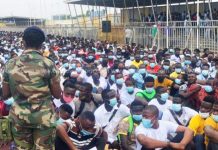Ghana has before independence till now, been noted for her rich diversity in tradition and culture.
The nation had a renowned traditional administrative system managed by the revered traditional rulers, until the British colonial rule was introduced and the people inherited a similar colonial mindset, with the end result clear for everyone to see.
Though there were pockets of conflicts, mainly due to territorial integrity amongst tribes, what united the people of Kwame Nkrumah’s Gold Coast was their way of life, including the food and festivals.
History appears to paint a rather bleak picture amongst tribes and cultures in Ghana, due to the conflicts that led to some ethnic groups not meeting for centuries. However, there are positive stories about the traditional cohesion that has existed among some ethnic groups, which cannot be over-emphasised.
Against the background of the bleak picture of traditional co-existence, it becomes a rather colourful spectacle when two separate traditional rulers meet, as that signifies unity, especially when tribal and political bigotry have tainted our minds.
Over the weekend, we observed such a scene once again, which had the nation talking. For us, we are not enthused with the attendance of the Asantehene, Otumfuo Osei Tutu II in Anglo for this year’s Hogbetsotso festival, after 120 years. The last Asantehene to attend such a festival was Kofi Karikari in the 19th Century.
This is because we know the longstanding relationship between the two ethnic groups, even in the days of Torgbui Adeladza II, the former King of Anlo and the Asantehene, Otumfuo Opoku Ware II.
We dare say that the Anlo-Awoamefia is traditionally revered by the Asantehene.
In the Ashanti Region, there is a place called Angloga, so one can understand the unity between these two.
But, for the ‘latter-day saints’ who may not know the history of Ghana’s chieftaincy, traditions or perhaps culture, we are happy they witnessed last weekend’s event and are making commendable remarks of unity.
In 2018, Togbui Sri III was in Kumasi with a delegation of about 170 from his traditional area to attend the last Akwasidae festival for the year.
Sometime in 2018, the Otumfuo made a historic visit to Akyem Abuakwa, Kyebi, where he joined the Okyenhene, Osagyefuo Amoatia Ofori-Panin II, to celebrate Ohum. We know the history between these two as well.
Last Saturday, the people of Anglo were honoured not only by the presence of the Asantehene but also by the Ga King, Nii Tackie Teiko Tsuru II and the Kwahumanhene.
The Chronicle is delighted that the current generation is not witnessing ethnic conflicts at the rate that it used to be, but rather the conglomeration of different ethnic groups to celebrate one another, as was seen in the Volta Region over the weekend. It depicts tolerance and respect for every ethnic group’s culture.
We can only hope that a great lesson is learned from this history to shape our way of thinking and accepting each other as one people with a common goal of making Ghana, our homeland, a conducive place to live.
Above all, expect that the political class would take a cue from the ways of these traditional rulers to advise themselves and their supporters to guard jealously the unity and cohesion we enjoy as a nation.
We will also like to urge other ethnic groups that are at loggerheads to find an amicable way to let peace prevail.
It is not right that we fight among ourselves. We only may open ourselves up for strangers to bypass us and take over our hard-earned properties, when we are busy at the battle field killing ourselves.
We can do more in terms of progress and development when we are together.








